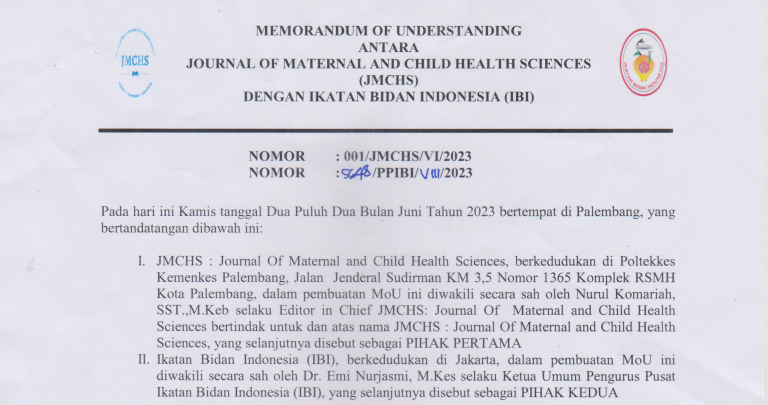Author Guidelines
Journal of Maternal and Child Sciences, published 2 (two) times each year (June and December) publishes research-based articles and literature-based papers in obstetrics.
Articles uploaded are articles that have never been published before and will never be published in whole or in part in a print/online version elsewhere.
Articles written in full as appropriate (article template):
Writing Guidelines:
The title is written in Indonesian with a maximum of 16 words without including the year. The title is made clear, concise, and attractive (Center, Times New Roman font 14, space 1)
Author's name is written: First Author1, Second Author2, Third Author3
Affiliation: Name of Institution
(correspondence author email: aaaa@bbbb.ac.id)
ABSTRACT (Times New Roman font 12, Bold, 1.5 space)
Made in English, which contains: Background: Introduction (1-2 sentences), research objectives (1 sentence). Method: Materials and methods are written 3-5 sentences. Results: research results are written 3-5 sentences. Conclusion: Must be related to the research objectives and the conclusion hypothesis is written in 1 sentence. Keywords: 3-5 words
The abstract must be clear, providing a brief description of the problem under study. Abstract written in one paragraph, avoid non-standard or uncommon references and abbreviations. If the abbreviation is important, it should be defined at the first mention. The number of sentences in the abstract is between 150 and 250 words. Abstract writing is preceded by using English then Indonesian. Writing using Times New Roman font 10 and space 1.
INTRODUCTION (Times New Roman font 12, Bold, 1.5 space)
The introduction contains the background of the research problem described by the inverted pyramid method starting from the global, national and local levels. References (relevant literature or research results) are written using the source number in each sentence after a period (.) adjusted to the bibliography. Example of a quote sentence: ……….. The results of the study reported that the incidence of anemia in pregnant women in the work area of Health Center A Palembang City was 25 cases.
The number of pages in the introduction is one to 1.5 pages or 3-5 paragraphs. Writing discussions using Times New Roman font 12 with 1 space. Each paragraph begins with a word that is indented into 10 digits. The final part of the introduction includes the research objectives.
METHOD (Times New Roman font 12, Bold, 1.5 space)
Design (describe the design and approach used in the research). Population, Sample, and Sampling (specify the population, number of samples, sampling technique used in the research). Inclusion and exclusion criteria should be stated in detail. Research variables are described (including independent and dependent variables). Instruments (questionnaires used in research must be explained in detail. Each instrument presents information, number of questions, scale or category, explanation of how to ensure the instrument, validity and instrument references). Procedure (describe the research procedure briefly and in detail). Data analysis (describe the software used for analysis, type of analysis and variables analyzed). Ethical Clearance (EC describes ethical considerations and states EC number).
Research that uses tools and materials, needs to write down the specifications of the tools and materials used. Qualitative research (case studies, phenomenology, ethnography and others) needs to add a description of checking the validity of research results. Writing uses Times New Roman font 12 with 1 space. Paragraphs begin with a word that is indented into 10 digits and there are no sub-headings in this section, displayed in 1-2 paragraphs.
RESULTS (Times New Roman font 12, Bold, 1.5 space)
Results must be presented continuously from the main results to the supporting results. The unit of measure used must comply with the applicable international system. The results of the study describe the characteristics of the research subjects, univariate analysis, bivariate analysis and multivariate analysis (if any). Report the main results/findings including (where relevant) statistical significance levels and confidence intervals. Interpretation of research results is made in narrative form, tables and figures are made at most 5 Tables / Figures. Writing using Times New Roman font 12 with 1 space. Paragraphs begin with a word that is indented into 5 digits and there are no sub-headings in this section.
DISCUSSION (Times New Roman font 12, Bold, 1.5 space)
The discussion section explains the research results that have been achieved or the review results that support or contradict the research results. The description of the discussion may not repeat the sentence of interpretation in the tables and graphs of the results of the analysis, however, it can be grouped for interpretation. The author explains problem solving and updates in writing this article or research. The author explains that this article is able to contribute to science, especially nursing. Writing the discussion using Times New Roman font 12 with 1 space. The paragraph begins with a word that is indented into 5 digits and does not use the organization of writing into sub-headings for each variable.
CONCLUSIONS AND SUGGESTIONS (Times New Roman font 12, Bold, 1.5 space)
Conclusions can contain brief and clear descriptions related to hypotheses and new findings regarding results and discussion with reference to research objectives. Suggestions can contain recommendations on the research conducted. Suggestions can refer to practical actions, new theory development and/or further research. Writing conclusions and suggestions using Times New Roman 11 point (upright) with 1 space. Paragraphs begin with a word that is indented into 5 digits, does not use numbering and is in 1 paragraph.
ACKNOWLEDGMENTS (Times New Roman font 12, Bold, 1.5 space)
Where appropriate, acknowledgments can be provided to the appropriate professional. Parties who provided assistance in this article such as technical, financial support, support from departments, institutions and those who contributed to the preparation of the report
REFERENCES (Times New Roman 12 font, Bold, 1.5 space)
The bibliography is written according to the IEEE writing rules. All references used in writing are listed in the bibliography in accordance with the provisions of article citation. The author only lists the literature used and relevant. Reference sources of at least 80% are literature published in the last 10 years. Reference sources in the form of journals from articles of at least 60% of the total bibliography. The references used are primary sources in the form of research articles in journals or research reports, related books, or articles from official sources. Articles published in independent nursing journals are suggested to be used as references. To maintain consistency in how to reference, quote and write a bibliography we recommend using standard reference applications such as Mendeley, Endnote, Zotero, RefWorks, or Colwiz. Reference writing example:
[1] Kemenkes RI 2021 Profil Kesehatan Indonesia 2021. (Jakarta: Kemenkes RI)
[2] Khasanah NA ,Sulistyawati W 2017 Buku Ajar Nifas Dan Menyusui, Cetakan Pertama. (Surakarta: CV Kekata Group)
[3] Tuti WMN 2018 Kebidanan 81 4453
[4] Pratiwi LN, Nurrohmah A 2023 P. Studi, and S. Ilmu 81 812
[5] Saraha RH, 2020 Kesehat. Poltekkes Kemenkes Ri Pangkalpinang, 81, 27, 2020 doi:
10.32922/jkp.v8i1.128.
[6] Dinkes Prov sumsel, “Membangun Sumsel Yang Sehat Sumsel Yang Maju Untuk Semua,” Profil Kesehatan. provinsi sumsel 2021, p. 259, 2021, [Online]. Available:
www.dinkes.sumselprov.go.id.
[7] Chomaria N 2020, Asi Untuk Anakku, 1st ed. (Jakarta: PT Gramedia) .
[8] Ohorella F, Simbung R 2022 Kreatif: Jurnal Pengabdian Masyarakat Nusantara 21 2836
[9] Julizar M, Fonna YN 2021 Getsempena Health Science Journal 11 3643
[10] Agung IGN 2006 Statistika Penerapan Model Rerata Sel Multivariat dan Model Ekonometri dengan SPSS. (Jakarta: Yayasan SAD Satria Bhakti)











